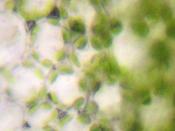All organisms need to exchange substances such as food, waste, gases and heat with their surroundings. These substances must diffuse between the organism and the surroundings. The rate at which a substance can diffuse is given by Fick's law:
So rate of exchange of substances depends on the organism's surface area that's in contact with the surroundings. Requirements for materials depends on the volume of the organism, So the ability to meet the requirements depends on the surface area : volume ratio. As organisms get bigger their volume and surface area both get bigger, but volume increases much more than surface area. This can be seen with some simple calculations for different-sized organisms. Although it's innacurate lets assume the organisms are cube shaped to simplify the maths - the overall picture is still the same. The surface area of a cube with length of side L is LxLx6, while the volume is LxLxL.
ORGANISMLENGTHSA (M")VOL. (M")S/A:VOL
bacterium1 mm6 x 10-1210-186,000,000:1
amoeba100 mm6 x 10-810-1260,000:1
fly10 mm6 x 10-410-6600:1
dog1 m6 x 1001006:1
whale100 m6 x 1041060.06:1
So as organisms get bigger their surface area/volume ratio gets smaller. Bacteria are all surface with not much inside, while whales are all insides without much surface. So as organisms become bigger it is more difficult for them to exchange materials with their surroundings.
Organisms also need to exchange heat with their surroundings, and here large animals have an advantage in having a small surface area/volume ratio: they lose less heat than small animals. Large mammals keep warm quite easily and don't need much insulation or heat generation. Small mammals and birds lose their heat very readily, so need a high metabolic rate in order to keep generating heat, as well as thick insulation. So large mammals can feed once every few days...


